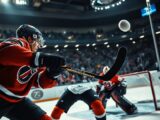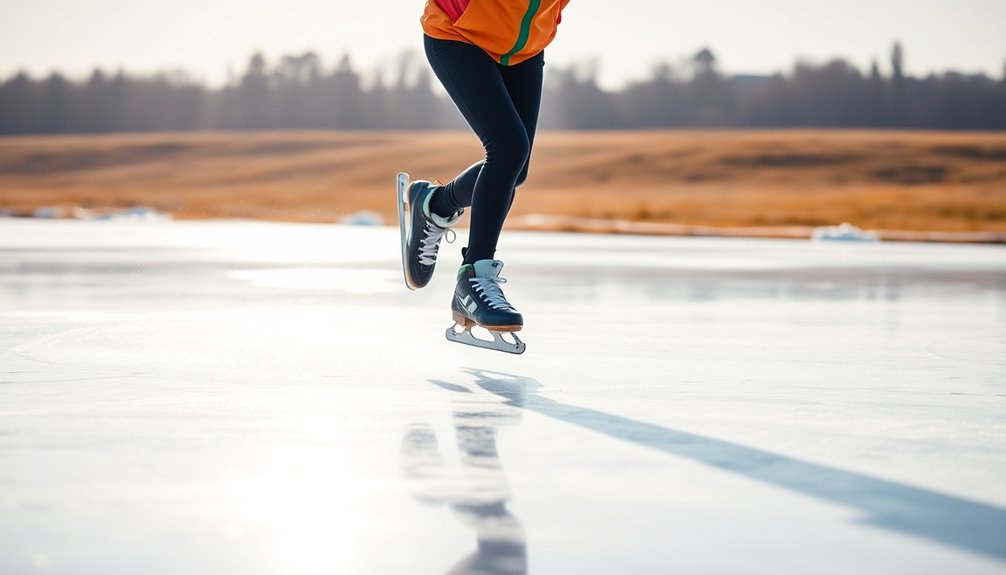
Ice and Field Crossover Skills Every Player Should Learn
January 1, 2025To excel in ice and field sports, mastering crossover skills is essential. They boost your speed and reaction time, allowing for quicker decision-making during games. Focus on key skating techniques like the fundamental stride and effective stopping methods. Enhance your gameplay by practicing stickhandling and precision passing, which elevate your control and teamwork. Don't forget to work on various shooting techniques, as accuracy and power are game-changers. Finally, honing your mental skills will sharpen your competitiveness. If you're keen to refine your abilities further, there's much more you can explore.
Importance of Crossover Skills
Crossover skills play an essential role in your performance on the ice or field, as they help you generate speed and maintain momentum. Mastering these skills allows you to shift effectively between offensive and defensive roles, keeping you agile and ready for action.
When you push off with one skate while crossing the other over, you enhance your acceleration and lateral movement, which is imperative for maneuvering tight turns and evading defenders. Developing your skill in endurance training methods will also help you sustain high levels of performance during intense gameplay. Agility training enhances your ability to move quickly and react to opponents effectively, further supporting your crossover skills.
Regular practice of crossover drills can greatly reduce your reaction time, empowering you to make quicker decisions in dynamic game situations. This agility makes a noticeable difference during critical moments, whether you're pursuing the puck or setting up a shot.
Strong crossover skills also contribute to your overall skating proficiency, which is essential for effective puck handling, passing, and shooting accuracy. Additionally, incorporating consistent practice into your training routine will help reinforce these essential skills and improve your game performance.
Key Skating Techniques
To elevate your skating skills, mastering key techniques is vital. In hockey skating, focusing on these foundational aspects can greatly improve your performance on the ice:
- Fundamental Skating Stride: Develop a proper knee bend, push at a 45-degree angle, and guarantee full extension with a strong toe-snap and recoil. This combination optimizes your speed and agility, enhancing your overall speed and agility training.
- Crossovers: When accelerating out of turns, practice stepping over your outside skate. This technique not only helps maintain balance but also maximizes power through your inside edge, allowing you to gain speed quickly.
- Backward Skating: Essential for defensive maneuvers, backward skating requires you to use short, powerful pushes while maintaining an upright posture. This stability is critical for effective control and quick reactions, particularly in high-pressure game situations.
Incorporating edge work into your training can enhance maneuverability, helping you execute quick stops and directional changes. Additionally, focusing on specific drills can further improve your reaction time and agility, essential for effective performance on the field.
Regularly practice specialized drills, such as changeover skating and quick feet exercises, to simulate game scenarios.
Mastering Stopping Techniques
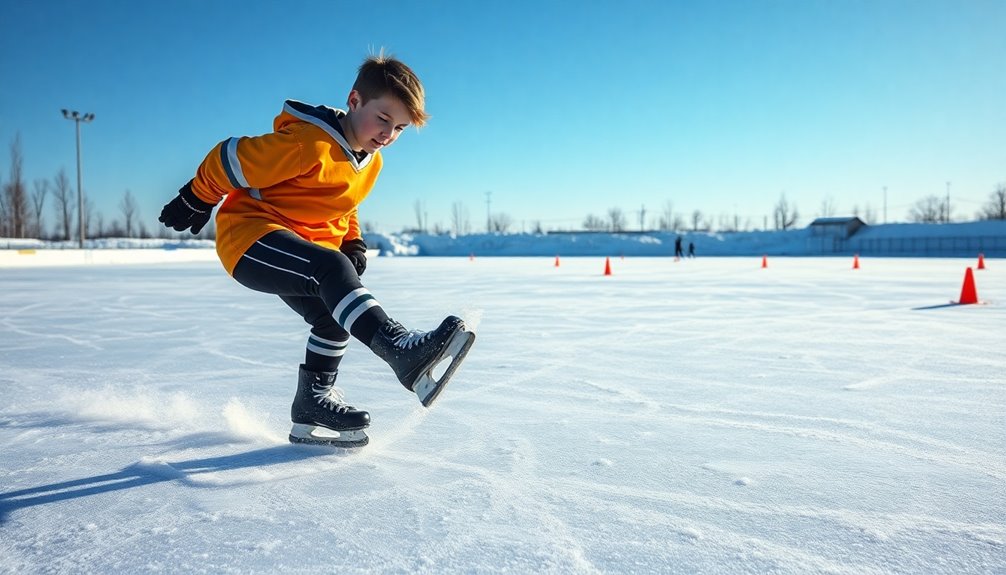
Mastering stopping techniques is important for maintaining control and positioning during a game. To effectively stop, you should keep your feet close together and push off both skate blades. This maximizes your control and stability, allowing for quick, efficient stops. Think of it like braking a car at turns—using short bursts of power from each skate enhances your momentum management on the ice.
When stopping, rotate your hips and distribute your weight primarily on your front leg. This guarantees smooth, controlled stops, which is essential for positioning yourself for the next play. Practicing both strong and weak-side stops is critical; it increases your versatility and helps you respond effectively in various game situations. Additionally, cardio training is vital for maintaining the stamina needed to perform these techniques effectively during extended play. Incorporating speed and agility training into your routine can further enhance your overall performance on the ice.
After you come to a stop, make certain you're facing the puck or play. This positioning reinforces your readiness for the next action, allowing you to react quickly and maintain fluid movement. Additionally, incorporating effective footwork drills can further enhance your stopping skills and overall agility on the ice.
Effective Stickhandling Strategies
Stickhandling is a fundamental skill that can set you apart on the ice. To elevate your game, focus on these effective stickhandling strategies:
- Keep your head up: Maintaining a head-up position while stickhandling allows you to stay aware of your surroundings, which helps you make better decisions, whether it's dodging a defender or setting up a play. This skill is similar to maintaining constant field awareness while dribbling in soccer to anticipate movements. Effective communication with teammates also enhances decision-making during gameplay.
- Utilize soft hands: Soft hands are essential for puck control. They enable you to make precise movements and execute effective maneuvers around opponents. The more comfortable you're with the puck, the more options you'll have. Practicing with small touches can help improve your control and precision.
- Incorporate advanced techniques: Mastering techniques like toe drags and saucer passes can greatly enhance your ability to navigate tight spaces. These moves create scoring opportunities and keep defenders guessing. Additionally, practicing moves like the Brazilian Elastico can improve your agility and deception during stickhandling.
Regularly incorporate stickhandling drills into your practice sessions. This builds confidence and encourages you to take calculated risks during games.
Remember, practicing with two hands on the stick provides greater control, while using one hand is reserved for specific situations to maintain puck possession.
Precision Passing Skills
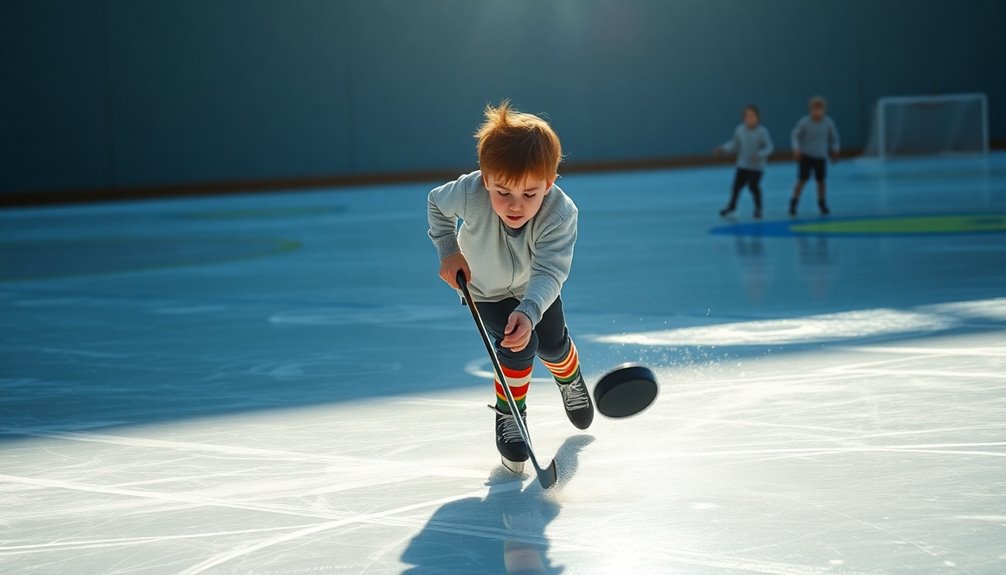
In today's fast-paced game, precise passing is essential for any player looking to elevate their performance on the ice. Accurate passing distinguishes good players from great ones, enabling your team to effectively execute plays against organized defenses. To truly master precision passing skills, focus on developing your ability to make cross-ice passes and chip pucks. These techniques can create breakaway opportunities, enhancing your offensive strategies in games.
Investing time in practicing soft touch passes is vital. This will help you develop the muscle memory needed to make precise passes under pressure during gameplay. Additionally, mastering step-over skills can enhance your agility and help create space for accurate passes. Incorporating drills that mimic real-game scenarios will further improve your ability to execute accurate passes when it matters most. Furthermore, understanding soccer field dimensions can significantly enhance how you communicate with teammates during passing plays.
Shooting Techniques for Success
To score effectively, you need to master various shot types, like wrist shots and slapshots, each suited for different situations.
It's not just about power; accuracy plays an essential role in hitting your target consistently. Additionally, understanding the types of free kicks can help players develop strategies for scoring opportunities in various game situations.
Shot Types Overview
Mastering different shot types can elevate your game and open up scoring opportunities on the ice. As a hockey player, it's vital to understand the various techniques available to you.
Here's a quick overview of essential shot types you should practice:
- Wrist Shot: This shot is key for precise scoring. It allows you to adjust your power while maintaining accuracy, perfect for different game situations.
- Snapshot: Combining quick release with accuracy, snapshots are ideal for tight spaces and fast-paced gameplay. You'll catch goalies off guard when you master this technique.
- Slapshot: Known for generating maximum velocity, slapshots are great for long-range shots. However, they require careful timing and technique to guarantee you maintain control.
Additionally, don't overlook the value of backhand shots and tip-ins.
Backhands can surprise goalies by coming from unexpected angles, while tip-ins demand excellent hand-eye coordination and positioning.
Accuracy and Power
Accuracy and power are vital elements in a player's shooting arsenal, directly influencing your scoring success. Mastering shooting techniques like wrist shots, slap shots, and snapshots is essential since each serves different game situations and demands specific body mechanics.
For wrist shots, focus on a precise follow-through and a firm wrist snap. This allows you to quickly release the puck while maintaining control, often leading to shots that can deceive goalies.
When it comes to slap shots, remember that generating considerable velocity requires proper weight transfer and strong lower body engagement. This guarantees you achieve both power and accuracy without sacrificing puck control.
Additionally, practicing tip-ins and deflections enhances your ability to score in traffic, as these techniques involve quick reactions and positioning to redirect shots effectively.
Invest in the right hockey equipment to complement your shooting techniques. A well-fitted stick can greatly improve your shot's accuracy and power.
Consistent repetition in practice will develop the muscle memory necessary to execute these techniques instinctively during high-pressure game situations. Emphasizing accuracy and power in your shooting will elevate your game and increase your scoring opportunities.
Practice Drills Suggested
Successful players often find that incorporating specific practice drills can markedly enhance their shooting techniques. By focusing on various shot types, you'll improve your effectiveness during games.
Here are some essential drills to include in your hockey practice sessions:
- Wrist Shots: Incorporate wrist shots to develop precision. These shots are vital for quick scoring opportunities, especially in close-range situations.
- Snap Shots: Utilize snap shots for their rapid release. Pay attention to weight transfer and follow-through for increased shot speed and accuracy during gameplay.
- One-Timer Drills: Implement one-timer drills to enhance your timing and coordination. Work on receiving passes and shooting in one fluid motion to catch goalies off guard.
Additionally, consider practicing slap shots with a focus on a low-to-high motion and control, and include deflection and tip-in exercises to improve your ability to redirect pucks and score from rebounds.
Mental Skills for Competitiveness
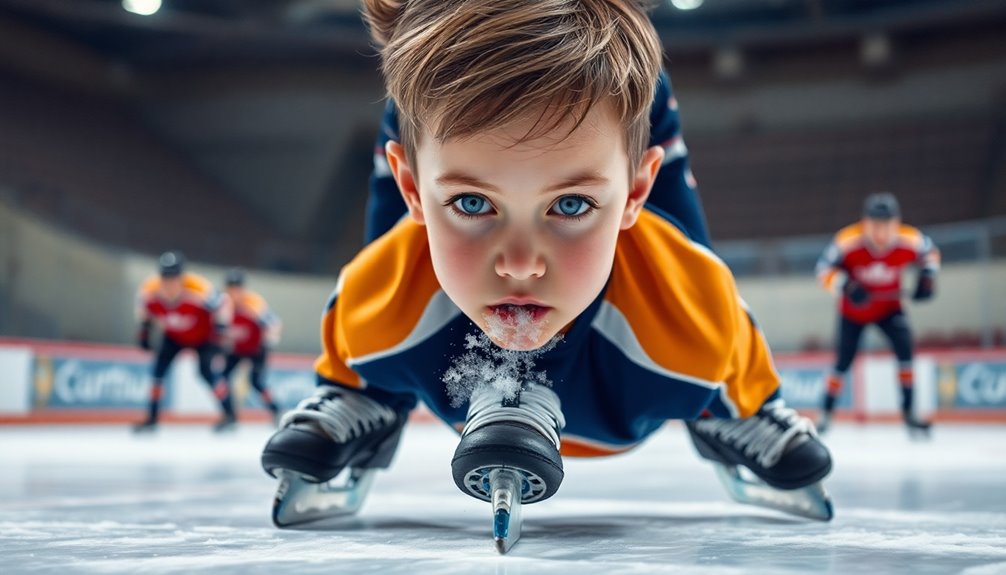
To really excel on the ice, honing your mental skills is just as indispensable as perfecting your skating techniques. Developing situational awareness and decision-making abilities allows you to adapt quickly during gameplay, ensuring you effectively execute tactics that leverage your skating strengths.
With practice, you can enhance your instinctive decision-making, enabling you to respond to cues without overthinking. This instinctive reaction is essential for maintaining a competitive edge.
Effective communication with your teammates is another critical mental skill. It fosters better execution of attack plans and adaptability against opposing defenses, leading to successful plays during games.
Consistent training can improve your mental clarity and focus, allowing you to perform physical and tactical skills instinctively rather than consciously.
Engaging in community discussions and seeking feedback can provide you with fresh insights into mental strategies. This ongoing skill development not only sharpens your competitiveness but also enriches your overall game performance.
Conclusion
Incorporating ice and field crossover skills can elevate your game considerably. Did you know that players who master both sports improve their overall athleticism by up to 30%? This versatility not only enhances your performance on the rink or field but also boosts your confidence and adaptability in various situations. By focusing on key skating techniques, stopping drills, and precise passing, you're setting yourself up for success. So, get out there and start honing those essential skills!

